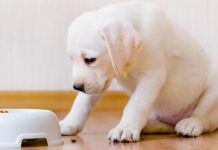Dogs, especially young dogs, sometimes swallow stupid things. In some cases, taking the right action immediately can save your dog’s life.
Sometimes it’s difficult to know what is an emergency and what is a ‘watch and wait’ situation. It’s better to phone your veterinary professional for advice and risk looking a bit silly, than to experience a lifetime of regret after wasting time scouring the internet for more information.
Who to call?
If you think your dog has swallowed something poisonous or harmful telephone your veterinarian for advice right away. No-one can give you good advice or reassure you that your dog will be okay, without talking to you and asking you for more information about your dog and what they just consumed.
If you can’t get hold of your veterinary professional contact the Pet Poison Helpline 855-764-7661. This is a 24 hour animal poison control service available throughout US, Canada and the Carribean.
In the UK you need the Animal Poison Helpline 01202 509000
The Australian Animal Poisons Helpline is: 1300 869 738 (AU) 0800 869 738 (NZ)
Dogs eat stuff they shouldn’t!
Like small children, young dogs are vulnerable to poisoning because they like to put things in their mouths.
Puppies and young dogs sometimes swallow household items such as bottle tops, buttons,and batteries. In the yard they may eat sticks, stones and dirt.
Swallowing a battery is a medical emergency for your dog. The acid inside can cause severe damage to your dog’s entire digestive tract. Do not delay seeking veterinary attention.
Houseplants are responsible for dog poisonings too and these incidents are becoming more common. You can find a list of toxic houseplants on the Frontiers In Veterinary Science website
Be careful what you share
Dogs that are often given human food to share are also vulnerable. Some common examples of human food known to cause accidental poisonings in dogs include: chocolate (especially dark chocolate), xylitol (a sweetener found in chewing gum, peanut butter and other human foods) and some nuts such as walnuts, or pecans.
Remember, if your dog has eaten something they shouldn’t, stay safe and check in with your vet
The Labrador Site Founder
Pippa Mattinson is the best selling author of The Happy Puppy Handbook, the Labrador Handbook, Choosing The Perfect Puppy, and Total Recall.
She is also the founder of the Gundog Trust and the Dogsnet Online Training Program
Pippa's online training courses were launched in 2019 and you can find the latest course dates on the Dogsnet website

















